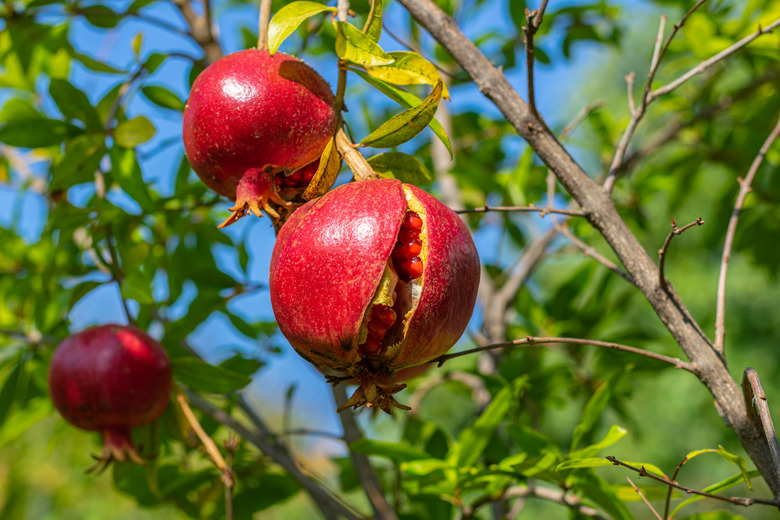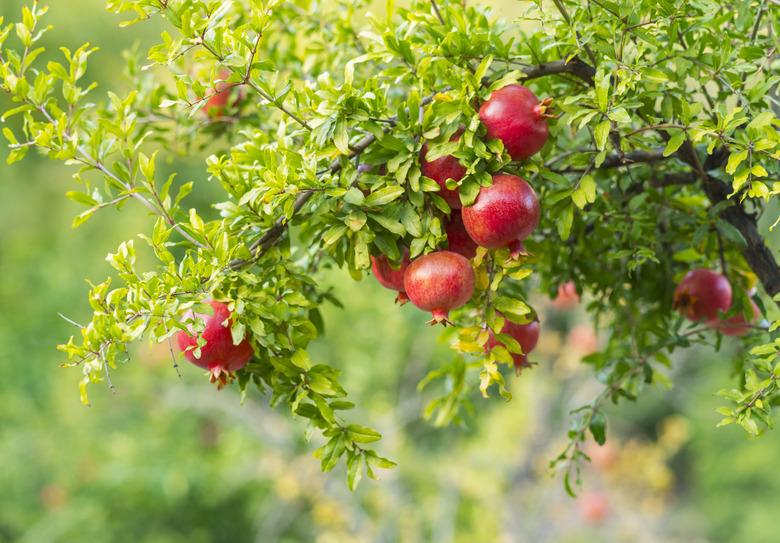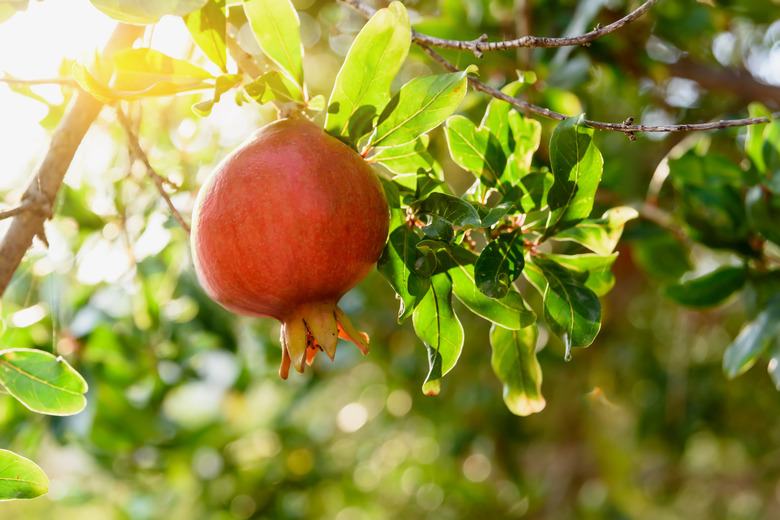How To Grow Pomegranates
We may receive a commission on purchases made from links.
The pomegranate tree (Punica granatum) is prized around the world for its distinctive ruby-red fruit that is loaded with juicy, antioxidant-rich arils — the juice-filled pockets surrounding the seeds. Native to the Middle East all the way through the foothills of the Himalayan Mountains, these hardy, low-maintenance plants thrive in warm, Mediterranean-like climates and are notably drought tolerant. Some pomegranate varieties are even frost tolerant down to 10 degrees Fahrenheit.
Pomegranate plants can be grown as either trees or shrubs and do perfectly well in pots, growing anywhere from 6 to 20 feet tall. During the growing season, the deciduous plants have dark, glossy-green leaves and pale-pink, deep-red or orange-red flowers that grow fruit between 2.5 and 5 inches with a tough rind in hues ranging from pinkish-yellow to purplish-red.
Best Uses for Pomegranates
Best Uses for Pomegranates
Pomegranates are known as a super fruit and have many health benefits. While they are well-known for their high antioxidant counts, they are also high in thiamin, riboflavin, niacin, calcium, iron, magnesium, phosphorus, potassium, zinc and vitamins B6, B9 and C. While the juicy arils can be consumed right from the fruit (the inner seeds may be either swallowed or spit out), they can also be used in salads, rice dishes and sauces and can be cooked with meats. The juice can be used to make grenadine syrup, pomegranate molasses, jellies, sorbets, wines and more.
Depending on the variety and your local growing conditions, the juice in the fruit may be highly sweet or fairly tart, with plants developing sweeter flavors when they receive more sun. Harvest times vary significantly depending on the varieties and the local climate, with some plants fruiting year-round and others producing only in fall. While you only need one pomegranate tree in your yard since they are self-pollinating, adding more than one tree for cross-pollination will result in increased fruit production.
When grown as a shrub, pomegranate plants usually reach between 10 and 15 feet tall and 6 to 8 feet wide. With proper training, the plant can instead grow as a tree with either one single trunk or multiple trunks; these can grow 15 to 20 feet tall and 10 to 15 feet wide. Certain dwarf species and shrubs grown in a pot may reach 6 to 10 feet in height.
Some of the most common cultivars include:
- Punica granatum 'Wonderful,' which is the most famous variety thanks to the POM Wonderful
brand that uses this cultivar's tangy, flavorful arils that have distinctively
soft seeds. - Punica granatum 'Kashmir' has a notably strong-flavored juice that is excellent
for juicing. - Punica granatum 'Sweet' is, as the name implies, a very sweet variety, and it also
produces at a younger age than other species. Unlike most other varieties, this fruit
tends to be either pink or green with a red flush. - Punica granatum 'Eversweet' has small seeds and is one of the only varieties with
clear, nonstaining juice. - Punica granatum 'Pink Satin' is like Eversweet in that it has nonstaining juice,
and it is also a good choice due to its soft seeds. - Punica granatum 'Granada' and 'Balegal' are both sweet-tasting and are most notable
for being cold hardy in zone 7. - Punica granatum 'Nana' and 'Multiflora' are two dwarf varieties that are good for
those hoping to grow plants in containers
How to Grow Pomegranates
How to Grow Pomegranates
- Common Name: Pomegranate
- Botanical Name: Punica granatum
- When to Plant: Spring
- USDA Zones: 7-12
- Sun Exposure: Full
sun - Soil Type: Any
soil will work, but loamy, acidic soils are ideal - When it's in Trouble: No fruit production, fruits split, limbs die
off, leaves or fruit develop blotches, fruit begins to rot on the stem - When it's Thriving: Glossy green leaves and vivid flowers that grow into healthy fruits
Starting Pomegranates From a Sapling
While propagation from seed is possible, a pomegranate tree grown from seed will not grow high-quality fruits like those grown from cuttings, which take years to develop roots. As such, it's preferable to purchase a sapling from reputable growers. Saplings may be sold with bare roots, in burlap sacks or in containers. Plants with bare roots or burlap-covered root balls should be planted in spring after the last frost in your area but before they exit their dormancy period. While container-grown plants can be replanted at any time of the year, spring and fall are ideal since it is best to avoid planting during particularly hot or cold weather.
Plant spacing varies based on how you intend to grow your pomegranate. For small trees, hedges or shrubs, make sure you leave at least 10 feet of space between plants. If you plan to prune the plant into a full-sized pomegranate tree, leave 15 feet of space between plants. Choose an area that is in full sun but sheltered from heavy winds.
Dig a hole that is one-and-a-half times the depth and two times the width of the plant's roots or existing container. Pour 1 cup of all-purpose fertilizer in the bottom of the hole and then mix the removed soil with an equal amount of manure or compost. Container-grown plants should be placed at the same depth they were in the container, whereas burlap and bare-root plants should have the soil level to the soil mark on the stem. Spread out roots in all directions before filling the hole with your modified soil mix. Gently tap down the soil as you go to ensure there are no large air gaps.
When the hole is half full, water gently to further fill any gaps and to ensure the deeper roots receive adequate moisture. Fill in the rest of the soil before mulching with a 3-inch-deep layer of compost or manure, leaving 2 inches of space around the base of the plant. Water thoroughly and keep the soil evenly moist as much as possible for the first year of the plant's life, taking care not to overwater.
For a potted pomegranate tree or shrub, select a container 18 inches deep and wide and use a commercial potting mix. After planting, apply a 5-10-5 fertilizer. After two years, replant in a container that is at least 24 inches deep and wide. To keep the plant manageably small, prune the top of the tree every winter.
In What Zone Do Pomegranates Grow Best?
In What Zone Do Pomegranates Grow Best?
Pomegranates do best in warm, dry climates with short, mild winters and low humidity, so they thrive in USDA zones 9 and 10. However, these hardy plants can do just fine in zones 8 through 12, and some of the more cold-tolerant varieties, such as Granada and Balegal, can survive in zone 7.
In areas that are too chilly for pomegranates, they can still be grown in a greenhouse or in a container so they can be carried indoors during the winter. Even in cool areas, pomegranates need a minimum of six hours of direct sun in order to grow healthy and produce fruit. Be sure to protect these plants from chilly winds to avoid cold damage.
Pomegranate trees exposed to temperatures below 10 degrees may suffer frost damage, and their trunks or branches may die off as a result. Because pomegranates are slow to grow their leaves back in the spring, wait until late spring to evaluate whether or not your tree suffered damage after a severe winter frost. If one or more trunks are damaged, remove the deadwood and encourage new suckers, as these can be trained to replace the damaged part of the plant.
When Should You Plant Pomegranates?
When Should You Plant Pomegranates?
Pomegranates can be planted at any time of the year as long as they are grown in containers, but it's best to start them in spring or fall to avoid extreme heat or cold, which could be hard on a newly transplanted pomegranate tree. Because bare-rooted plants and trees sold in burlap sacks are sold in their dormant periods, it is best to plant these in early spring as soon as the soil is workable because they need to be in soil before leaving their dormant stage.
Soil, Sunlight and Water Recommendations for Pomegranates
Soil, Sunlight and Water Recommendations for Pomegranates
When it comes to soil, few fruit trees are as indiscriminate as pomegranates. While they prefer slightly acidic, soft, loamy soil that is well-draining, these plants can grow in just about all soils, ranging from sandy to clay and even alkaline soil. For best results, mulch the plants with a thick layer of compost or manure every spring or add a compost tea or a fish emulsion solution every two weeks. While you can also apply a more traditional liquid fertilizer in fall and spring, avoid fertilizers high in nitrogen, as this can reduce fruit production.
Be sure to provide plants with a minimum of six hours of full sun a day. More sun will not only increase the amount of fruit produced by your tree but will also make it sweeter.
While new pomegranate plants should be watered regularly, once they have become established, they are highly drought tolerant and can survive for years with minimal water. Naturally, though, less water means less fruit, so it's best to provide adequate soil moisture throughout the growing season. Deep water once a week when there isn't any rainfall and keep soil moist but not wet in late summer and early fall, as this will maximize your production and reduce fruit splitting. Avoid getting water on the pomegranate fruit because this can also result in splitting.
How to Winterize Pomegranates
How to Winterize Pomegranates
If you live in a cool area and have a container-grown plant, winterization means remembering to bring the plant indoors. For most growers, though, these plants do not require any winter-specific maintenance, though winter is the best time to prune a pomegranate tree. Pomegranate trees do not need to be pruned but doing so can help increase fruit production and can also determine the shape a young tree will eventually take.
When left on their own, they will grow into a bushy shrub with many trunks and suckers sprouting from the root and crown area. By pruning off these suckers and forcing the plant to grow between one and four trunks, you can make it grow into a tree.
Whether growing a bush, hedge or tree, it's important to avoid pruning the first year to encourage healthy development. In the second year, choose whether you want a hedge, shrub or tree. For hedges, leave all the main trunks and suckers in place and trim the exterior branches to create the desired overall shape. For shrubs, choose four to six main trunks and prune the others to the ground, as this will make harvesting easier, increase the amount of fruits and increase the size of the fruits.
To grow a pomegranate tree, decide how many trunks you want — between one and four. Remove suckers throughout the year. For the tree's second and third years of life, encourage a stocky framework that promotes healthy growth. After that, trim back low branches once a year to encourage the tree to grow taller or, for a short tree, trim the top of the branches.
Whatever type of pomegranate plant you've chosen to grow, light pruning of old, crossing and crowded wood can encourage healthy growth and increase fruit production. Flowers grow on branches that are between two and three years old, so be cautious not to remove too much new growth or you may drastically limit the amount of fruit you grow in upcoming years.
How to Harvest Pomegranates
How to Harvest Pomegranates
Harvesting pomegranate fruit isn't difficult, but it may be difficult to know when to harvest because plants vary so much. Some cultivars start fruiting at only one year old, while others take five years to bear fruit. Similarly, plants can fruit year-round, twice annually or once a year depending on your local weather. To make matters more confusing, some pomegranates will be bright red or even reddish-purple when ripe, while others will be yellowish-brown or even greenish-pink. For this reason, it's a good idea to familiarize yourself with your specific cultivar and the typical harvest season in your region.
While colors may vary based on the variety, pomegranates tend to become less circular and more angular as they approach peak ripeness, and the stem and blossom end will begin to flatten. When unripe, the skin will be very shiny and glossy, and it will become more matte as it ripens. If the skin starts to look leathery, remove the fruits immediately because they are becoming too ripe. Fruit left on the tree after it ripens will often split and be eaten by birds. Fruit should be cut from the tree to avoid accidentally knocking down unripe fruit. Ripe fruit will twist easily from the stem.
Always harvest fruit when it starts to split and eat or preserve it immediately because it will go bad quickly. Otherwise, pomegranates can be stored at room temperature for many weeks or kept in the refrigerator for months. Pomegranates get darker skin and softer seeds and become more flavorful as they age. Once removed from the fruit, pomegranate seeds can be stored in the refrigerator for up to a week or kept in the freezer for many months.
Common Pests and Other Problems for Pomegranates
Common Pests and Other Problems for Pomegranates
Pomegranates are truly low-maintenance and are subject to few pests and diseases. Even so, it never hurts to periodically look for leaf-footed bugs, mites and leafrollers, which will not destroy the plant but may damage your crop. If you find these pests, treat the problem by applying either insecticidal soap or horticultural oil. Remove debris, including fallen fruit, over the winter to ensure insects do not overwinter in or on your trees.
Other common problems include plants not fruiting, fruit falling before it matures or fruit splitting. Generally, when plants aren't fruiting, it's because they're simply too immature. If your mature plant isn't fruiting, it could be because it is unhappy due to excess moisture around the roots, overfertilization or lack of sunlight. Similarly, if fruit is falling before it ripens, it's most likely because the tree is still maturing. After a year or two, it should start developing fully grown fruit.
Fruit splitting is perhaps the most common problem growers have with their pomegranate fruits. To avoid this issue, evenly water the plant, mulch around the base during the growing season, avoid getting water on fruits and harvest as soon as fruits are ripe.
Common Diseases for Pomegranates
Common
Diseases for Pomegranates
Diseases in pomegranates are relatively rare, but plants may be affected by leaf blotch, fruit spot, Alternaria fruit rot and Aspergillus fruit rot. Leaf blotch appears as dark blotches on the leaves and will cause the infected leaves to fall prematurely. Fruit spot is similar in that it causes dark spots to appear on the fruit. Both of these diseases can be treated with fungicide but be sure the product you choose is rated as safe for use on edible plants.
Both Alternaria and Aspergillus fruit rot are fungi that cause fruits to rot and become inedible. They are spread through cracks in the fruit and by pests, so treating pests as soon as you notice them, working to minimize cracks in your fruit and removing cracked fruit when you discover it can reduce the spread of these diseases.


